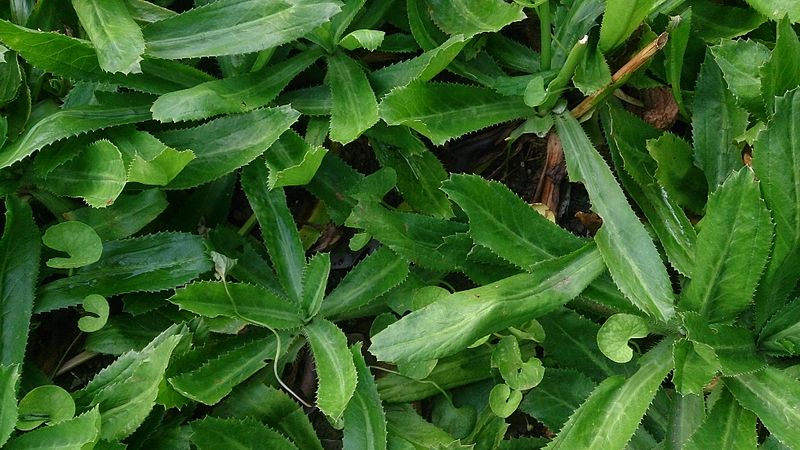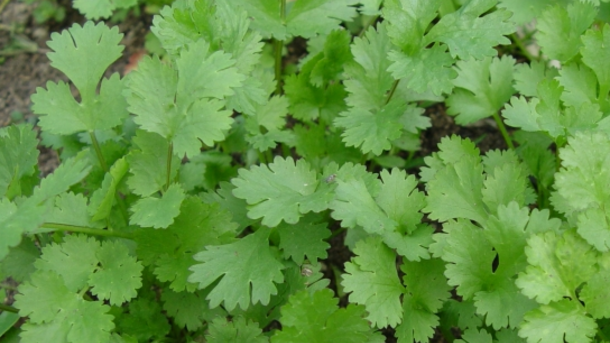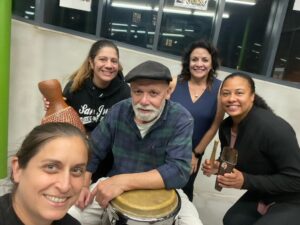Culantro/ Cilantro: No, It’s Not the Same!
by Angela Lugo
Culantro (Eryngium foetidum L.,Apiaceae) is both a cooking and medicinal herb well known in the Caribbean, West Indies and the Far East. It is a biennial herb indigenous to continental tropical America and the West Indies. The herb is commonly found along moist or shaded pathways and in heavy soils. In these areas, it proliferates like a weed. However, here in the United States, outside ethnic neighborhoods, it is not very well known. Most confuse it with the now ubiquitous cilantro, found in tacos, salads and many things Mexican. Some of its common names are spiny coriander, shado beni and bhandhania (Trinidad and Tobago), chadron benee (Dominca), Coulante (Haiti), recao (Puerto Rico) and Fitweed (Guyana).
In Vietnam and the rest of Asia, culantro is also known and is most popular in Thailand, Malaysia, and Singapore, where it is commonly used with or instead of cilantro for soups, noodle dishes, and curries. I have not found how recao got to these regions, but there is a huge presence of Indians and Asians in the islands mentioned above, so it is easy to see how it could have been transported to the Asian countries. Today, because of the presence of increasingly large West Indian, Latin American, and Asian immigrant communities in metropolises of the US, Canada and the UK, there has been created a large market for culantro, and large quantities are today exported from Puerto Rico, the Caribbean and Trinidad in the West Indies to these areas.
Every time I cut or cook with recao, my mind flashes back to my childhood. As a child, I and my family moved to New York from the island of Puerto Rico. In the city, we continued our food traditions, gravitating towards bodegas that had all our spices and herbs to flavor our foods or concoct remedies for various ailments. Recao was definitely something we always had in our kitchen. Every two weeks my mother would buy onions, garlic, ajicitos dulces (sweet miniature peppers), tomatoes, cumin and recao for our sofrito, the seasoning that goes into everything, in our beans, soups, fricassees, yellow rice, stews, etc. My mother would peel the onions and garlic, cube and chop everything else and put through a manual meat grinder (the food processor of yore). She would then season with salt , cumin, oregano and place in a glass jar and refrigerate. She always had extra recao leaves which she would add to the various dishes at the last minute for added flavor. So, recao was not an exotic herb for me; it was a staple.
Recao or culantro has an aroma and taste similar to the popular cilantro. In fact, if cooks cannot find culantro for sofrito, they substitute cilantro. However, recao has a stronger smell to it and its leaves are tougher. Also known as broad leaf or spiny coriander, its leaves can grow to up to 10 inches, are long and broad with serrated edges. It can grow in poor soil with little fertilizer, but it also does well in pots. Culantro plants are hardy and prefer partial shade, even though they tolerate full sun. Some growers feel that cutting the shoot that contains the seeds will encourage leaf production, others do not. To harvest, cut the leaves at the soil line with a knife or scissors, leaving the new leaves to continue growth. I usually just pinch the leaves I need for a dish and scissors or a knife when harvesting a big bunch. A word of caution, its spiny leaves sometimes makes it uncomfortable to harvest without gloves. Also, because of its tough leaves, if I do put it in my salad, I cut it into thin ribbons; otherwise, I use cilantro and leave the culantro for teas or cooking. The plant throws out what looks like a green straw with a floret at the end; this floret is what contains the seeds which can be stored for subsequent plantings. In the tropics, it is self seeding.
In the garden, recao attracts lady bugs, lacewings and other beneficial insects. It also seems that aphids do not like this herb.
Culantro is rich in iron, riboflavin, calcium, and carotene. Its leaves are an excellent source of vitamin A, B2, B1 and C, powerful antioxidants which help vitality and immunity. They also contain phosphorous for strong bones.
Medicinally, the leaves and roots are boiled for fevers, chills, vomiting, diarrhea, colds and convulsions. The water is taken for pneumonia, flu, diabetes, constipation, and malaria fever. In chutneys, the leaves are used as an appetite stimulant. Culantro is anti-inflammatory and contains large amounts of plant sterols, so it can help with asthma, arthritis, and swelling. It also contains trimethylbenzaldehydes, a powerful pain reliever. Culantro tea can sooth earaches, stomachaches and headaches. In some countries, culantro is also called Fitweed because it is said to help prevent or sooth away epileptic fits.
Since the United States and other parts of the world do not know about culantro, there is not a lot written about this herb. However, like cilantro, culantro is slowly becoming better known and easier to find. Many Asian farmers markets carry it, and definitely, you can find it in any latino market. If you like cilantro, you need to try culantro.
Basic Sofrito:
Ingredients:
- 2 big Spanish onions
- 1 head of garlic
- 2 small tomatoes
- 1 red pepper
- 15 leaves of recao
- 1 tablespoon oregano
- 1 teaspoon cumin
- 1 teaspoon sea salt
- 2 tablespoons olive oil
Instructions:
- Rough chop in food processor
- Put in glass jar and refrigerate
A heaping tablespoon will usually be enough for any dish for two people. However, depending on your taste, you may add more to your dish. This should be enough sofrito for about 10 servings. It stores well in the refrigerator for a couple of weeks. But, if I am going away or make a bigger batch, I freeze it.
When making any dish, heat some olive oil, put 1 tablespoon of sofrito in the heating oil, add tomato sauce or paste, stir and slowly sauté. After 5 minutes, just add to your dish. If you like a fresher recao taste, add a couple of leaves about 2 minutes before the dish is done. Enjoy!
More About the Author
Angela Lugo is an Associate Professor of English at Middlesex County College in Edison, NJ. She is also on the board of Raices Cultural Center, a non-profit organization dedicated to eco-culture, seed saving and eco/cultural archivism. She was born in San Sebastian, a small mountain town in the island of Puerto Rico, and comes from a long line of curanderos; her grandmother Cecilia was the go to person for folk and natural remedies for both spiritual and physical ailments. Angela grew up hearing about the native herbs of the island and their uses from both her grandmother and her father. Today, she continues to learn and research about these foods and herbs, both for culinary and medicinal uses.
Bibliography
- Benedetti, Maria Dolores Hajosy. Earth & Spirit Healing Lore and More from Puerto Rico. Maplewood, NJ: Waterfront Press, 1989.
- Haider, Paul, Dr. “Culantro (Racao) – A Wonderful Healing Herb and Spice.” Relax to Success. December 17, 2013. Accessed May 25, 2016. https://paulhaider.wordpress.com/2013/12/17/culantro-racao-a-wonderful-healing-herb-and-spice/
- Lozada, Eliab. “Culantro.” Just4Growers. Accessed May 25, 2016.
- Nunez, Esteban Melendez, Ph.D. Plantas Medicinales De Puerto Rico. San Juan: Editorial De La Universidad De Puerto Rico, 1982.
- Ramcharan, Christopher. “Culantro: A Much Utilized, Little Understood Herb.” Accessed May 25, 2016. https://hort.purdue.edu/newcrop/proceedings1999/v4-506.html/





